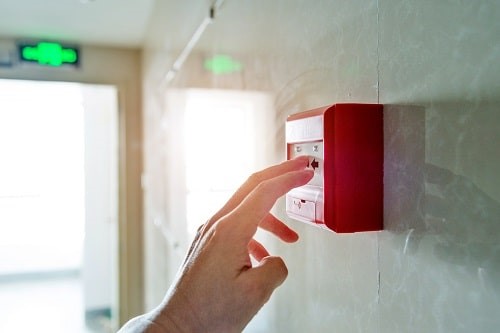Selecting a provider of fire safety services who has been independently assessed and certificated to ensure their competence will help a business ensure it is properly managing fire safety risks.
Features
Competence is key
It has now been four years since the tragic Grenfell Tower fire, which highlighted significant fire safety failings in all types of buildings. Understandably high rise residential buildings (HRRBs) and high risk buildings (HRBs) have been the key focus, but systemic failures in fire safety measures for the entire built environment need to be addressed.
Despite some criticism of the Building Safety Bill, the UK Government stated last year: “The [Building Safety] regulator will have 3 main functions: to oversee the safety and standard of all buildings, directly assure the safety of higher-risk buildings; and improve the competence of people responsible for managing and overseeing building work... At each of these 3 stages, it will be clear who is responsible for managing the potential risks and what is required to move to the next stage enabling a ‘golden thread’ of vital information about the building to be gathered over its lifetime.”
To aid premises management, the UK fire safety industry has specialised UKAS Accredited Third Party Certification (TPC) in place to provide quality evidence of the competency of contractors who offer specific fire safety services, such as the design, installation and maintenance of life safety systems.
Fire Risk Assessment
Members of the British Safety Council will know that a fire risk assessment is a critical action required to determine the adequacy of fire safety in a building. What is sometimes overlooked however is the frequency of re-assessments, especially over the last few years we have experienced.
 British Standards stipulate regular reviews of systems, especially regarding testing and maintenance. A clear example of this is a fire detection and alarm system. Photograph: iStock
British Standards stipulate regular reviews of systems, especially regarding testing and maintenance. A clear example of this is a fire detection and alarm system. Photograph: iStock
Inevitably all types of changes have been made to the use of buildings throughout the Covid-19 pandemic and as we all head out of various lockdown measures this may instigate further reviews of all safety measures with projected increase or changes in footfall.
The Scottish Government’s guidance on fire safety for premises previously stated the excellent observation that “undertaking a fire safety risk assessment is not a one-off exercise. The risk assessment is a means to an end, not an end in itself. The outcome of the assessment needs to be acted upon, risks need to be controlled in a practical way, and fire safety arrangements need to be in place.”
Therefore, several actions may be required following your life safety fire risk assessment.
UKAS Accredited Third Party Certification schemes exist within the fire safety market to support appropriate British Standards and best working practices. For example, the Fire Sector Federation (FSF) publishes the Guide to Choosing a Competent Fire Risk Assessor, which states “no matter who carries out the fire risk assessment the duty holder retains the responsibility for ensuring the adequacy of that assessment. If employing a specialist to undertake your fire risk assessment, whilst you are not expected to be an expert in fire safety, you should make reasonable checks to ensure that they are competent to do the job properly.”
The FSF guidance outlines the three UKAS Accredited Third Party Certification company schemes available as a “principal method by which [organisations offering fire safety services] can demonstrate their competence”. These are BAFE SP205, Warringtonfire FRACS and IFCC0099.
Systems, standards and safety regulation
In March Dame Judith Hackitt, who led the Independent Review of Building Regulations and Fire Safety commissioned by the Government following the Grenfell tragedy, provided an update on the forthcoming Building Safety Regulator via the Health and Safety Executive’s Building Safety Regulator ebulletin.
She stated that the Building Safety Regulator plans to drive “industry culture change” by “setting new standards for what we expect of new build in the future whilst maintaining a proportionate and affordable approach to existing buildings to achieve an acceptable level of safety. For those who have been close to HSE’s approach to regulation for many years the principle of reasonable practicability is so well understood that it is easy to forget that others are not at all familiar with the need for proportionality.”
Any changes implemented following a fire risk assessment should also incorporate applicable reviews of any safety systems and provisions in a building. Appropriate British Standards also stipulate regular reviews of systems, especially regarding testing and maintenance.
 Stephen Adams, Chief Executive of BAFE Fire Safety Register
Stephen Adams, Chief Executive of BAFE Fire Safety Register
A clear example of this is a fire detection and alarm system. These systems need to always be operational which means that, unlike a security system, there is not necessarily a daily interaction with the system to determine any faults at an early stage. A building’s security alarm system is generally switched on when the occupants leave, and off when they arrive the following day, providing an opportunity to identify any faults or malfunction in the system. A fire detection and alarm system may not always be checked daily, simply because it is ‘always on’ and therefore the person in control of the building or site may not necessarily always carry out daily checks to ensure it is working correctly.
British Standard 5839-1 (Fire detection and fire alarm systems for buildings Part 1: Code of practice for design, installation, commissioning and maintenance of systems in non-domestic premises), outlines the weekly and monthly recommended routine testing of these systems. The Standard states that “periodic inspection and servicing needs to be carried out by a competent person with specialist knowledge of fire detection and fire alarm systems, including knowledge of the causes of false alarms, sufficient information regarding the system, and adequate access to spares.” (Section 6: Maintenance, 45.1 Inspection and servicing – commentary).
The standard also states that “competence of a fire alarm servicing organization can be assured by the use of organizations that are third-party certificated, by a UKAS-accredited certification body, to carry out inspection and servicing of fire alarm systems”. Further guidance for life safety systems and provisions (including fire alarms, fire extinguishers, emergency lighting and fire risk assessment) can be found on the BAFE website at www.bafe.org.uk
Reasonably practicable action
In the executive summary of her report, Building a Safer Future: Independent Review of Building Regulations and Fire Safety, Dame Judith Hackitt recommended that there should be “a clear and identifiable dutyholder with responsibility for building safety of the whole building. The dutyholder during occupation and maintenance should maintain the fire and structural safety
of the whole building, and identify and make improvements where reasonable and practicable.”
BAFE are undoubtedly major advocates of UKAS Accredited Third Party Certification for providers of fire safety services.
We would therefore like everyone responsible for fire safety management at a premises to only use providers of fire safety services that have undergone independent Third Party Certification by a UKAS Accredited Certification Body to ensure they have quality evidence of competency to offer specific fire safety services. We would urge those in control of fire safety at all premises to only use Third Party Certificated fire service providers, regardless of whether they use providers who have been Certificated and registered under the various BAFE schemes or by another provider of independent third party certification.
Our most recent campaign, ‘Don’t Just Specify, Verify’, highlights both the benefits of using fire safety service providers that have achieved Third Party Certification and how, when deciding who to award fire safety work to, it is crucial to verify they have the appropriate Third Party Certification for the specific type of work they will be undertaking at your premises.
Fire safety service providers that have achieved independent Third Party Certification of their competence under the BAFE scheme (or from another provider of Third Party Certification services), will only be certificated as competent to undertake and provide specific fire safety services. So, if you are awarding a contract for fire safety work, and you want to only use a provider who has achieved Third Party Certification for all the services they will be providing to you, you must verify that they have achieved Third Party Certification for all the work they will be undertaking.
In the case of the BAFE scheme, you can do this by checking the BAFE Fire Safety Register. This is an online publicly available register that clearly states exactly which fire safety services the provider has achieved Third Party Certification for under the various BAFE certification schemes.
BAFE Fire Safety Register
BAFE is the independent registration body for Third Party Certificated fire safety service providers across the UK.
BAFE runs a number of schemes under which providers of fire safety services can apply for independent assessment to achieve Third Party Certification, demonstrating competency to deliver specific fire safety services. These include fire risk assessment; design, installation and maintenance of fire detection and alarm systems; fire extinguisher servicing and maintenance and other services.
The BAFE Fire Safety Register is available to access at bafe.org.uk and can be used to source or verify BAFE registered organisations.
If you require specific fire safety services that are not covered by the BAFE schemes, BAFE still strongly advises that you check your chosen provider holds the appropriate Third Party Certification for that service via another organisation.
Stephen Adams is Chief Executive of BAFE Fire Safety Register
FEATURES

Sedentary working and how to combat the ‘sitting disease’
By Gavin Bradley, Active Working on 05 April 2024
Prolonged and excessive sitting poses a major risk to our health, but the Get Britain Standing campaign and On Your Feet Britain Day on 25 April are a great way of encouraging workers to sit less and move more.

Company culture and wellbeing: a crucial link
By Bex Moorhouse, Invigorate Spaces on 05 April 2024
Investing in measures to support worker wellbeing will be ineffective unless the company culture genuinely incorporates values like teamwork, involvement, flexibility and innovation.

Office design and culture: happier and healthier staff – or the opposite?
By Guy Osmond, Osmond Ergonomics on 03 April 2024
Applying ergonomic principles to workstation set-ups and ensuring the physical environment supports neurodivergent people are just some of the ways of creating an office where everyone can thrive, but a supportive and positive organisational culture is vital too.


